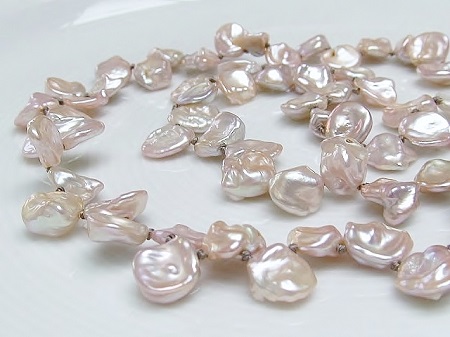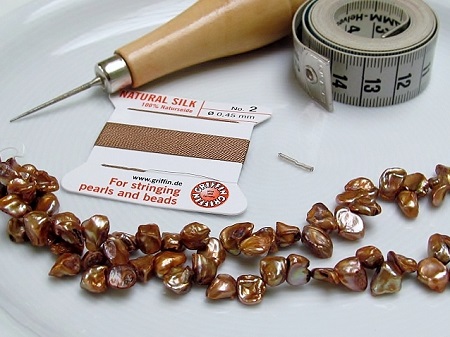Traditional pearl knotting
This technique can also be used with other beads, and even to create a floating effect. Because of the sharp edge crystal beads are not recommended though. Use a much heavier cord such as a # 6. The Griffin knotting cord for a floating effect should be passed through a curling iron in order to iron out the fold creases ;-)

Material:
- a strand of freshwater cultured pearls http://dunebeads.com/en/freshwater-cultured-pearls
- Griffin silk stringing cord # 2, 2 meter card with needle – or the needle you use with your seed beads - http://dunebeads.com/en/silk-stringing-cord-griffin
- textile adhesive
- a clasp https://dunebeads.com/en/jewelry-clasps
- a flush cutter for the bullion or French wire - https://dunebeads.com/en/beadsmith-pliers-for-jewelry-making - and a tape measure
- 2,5 cm bullion or French wire 0,7 mm, cut precisely in two - http://dunebeads.com/en/french-wire-0-7-mm-sterling-silver
- a bead reamer or pearl reamer to enlarge the hole of the pearls – a needle file or a thin hand drill of your friend my also do the trick

Calculating the length of the knotting cord
Make the following addition:
- 2 times the length of the necklace
- 30 cm to attach the clasp
- 1 cm per pearl for the knot
Example: 40 cm necklace with 0,6-0,7 mm pearls: (2x40) + 30 cm + (40:0,7) = 167 cm
May I suggest that you do not shorten the 2 m knotting cord in such a case. The calculation is especially important so you know you have enough cord. You want to avoid having to start over.
Instructions – how to attach a clasp and knot pearls ... see - part 3



